Why Choose a 12V RV Air Conditioner?
Advantages of 12V Air Conditioners for RVs
12V air conditioners are a game-changer for RV enthusiasts. Designed for compact and mobile living, they offer unmatched convenience and efficiency. Here’s why they stand out:
- Energy Efficiency
Unlike traditional 110V or 220V air conditioning units, 12V air conditioners consume significantly less energy. They can be powered by the RV’s battery system, reducing dependency on shore power or generators. - Eco-Friendliness
Their low power consumption makes them a sustainable choice. Many RVers pair 12V air conditioners with solar panels, minimizing their carbon footprint. - Compact and Lightweight Design
12V units are specifically designed for RVs, ensuring they don’t take up excessive space or add unnecessary weight, which is critical for maintaining fuel efficiency. - Compatibility with Off-Grid Living
If you enjoy camping in remote areas, a 12V air conditioner allows you to stay cool without relying on electrical hookups. This is ideal for off-grid adventurers. - Ease of Installation
Most 12V air conditioning units are designed for straightforward DIY installation, saving you money on professional services.
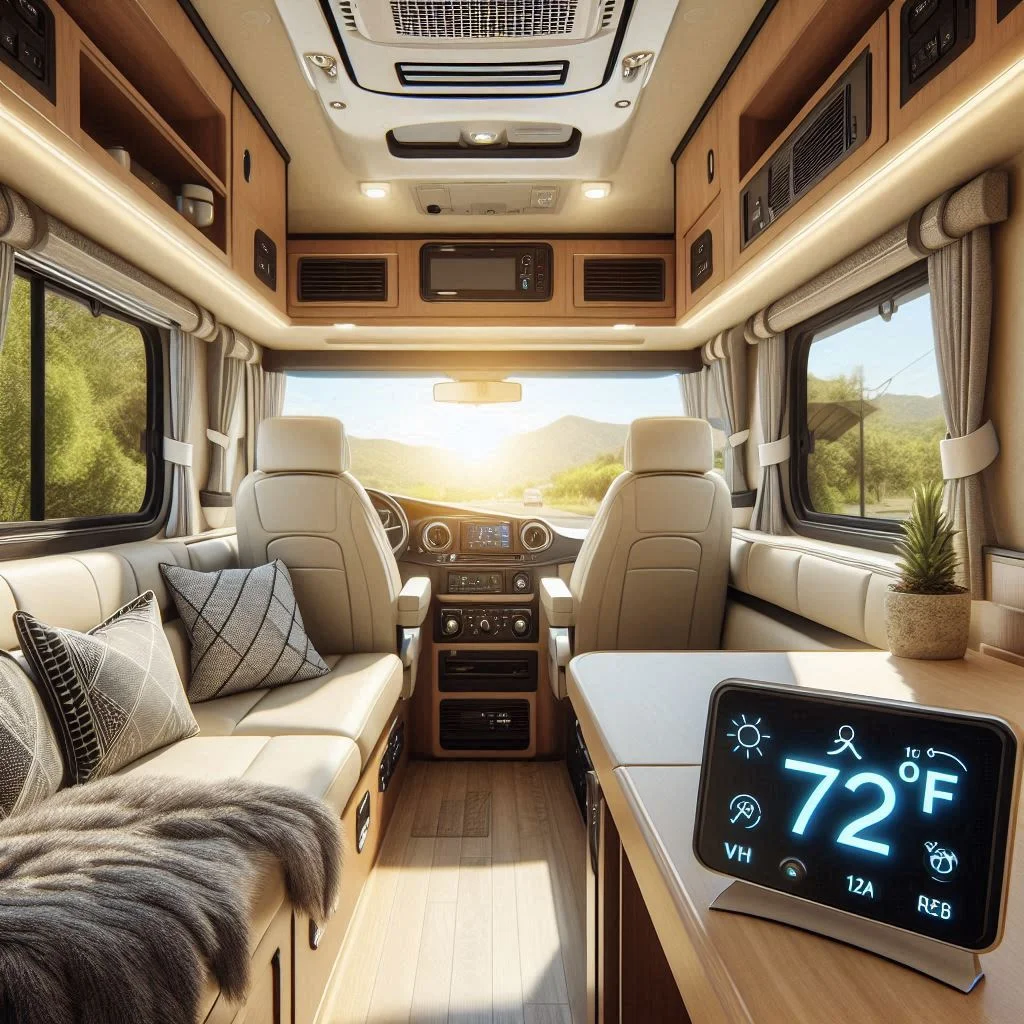
Common Misconceptions About 12V RV Air Conditioners
Despite their advantages, several misconceptions about 12V air conditioners deter potential users. Let’s debunk some of the most common myths:
- “12V Air Conditioners Are Not Powerful Enough”
Many believe that 12V units can’t adequately cool an RV. In reality, modern 12V air conditioners come with impressive BTU ratings, capable of cooling even larger RVs effectively. - “They Consume Too Much Battery Power”
While any air conditioner requires power, 12V units are designed to maximize efficiency. Paired with solar panels and sufficient battery capacity, they can operate for hours without draining the system. - “They’re Too Expensive”
Although the initial cost might seem high, 12V air conditioners save money in the long run by reducing generator use and lowering energy consumption. - “Installation Is Too Complicated”
Most 12V air conditioners come with comprehensive manuals and even video tutorials. With basic tools and a little patience, even first-time installers can set them up. - “They Lack Heating Options”
Many modern 12V air conditioners offer dual functionality, providing both cooling and heating, making them a year-round solution for climate control in RVs.
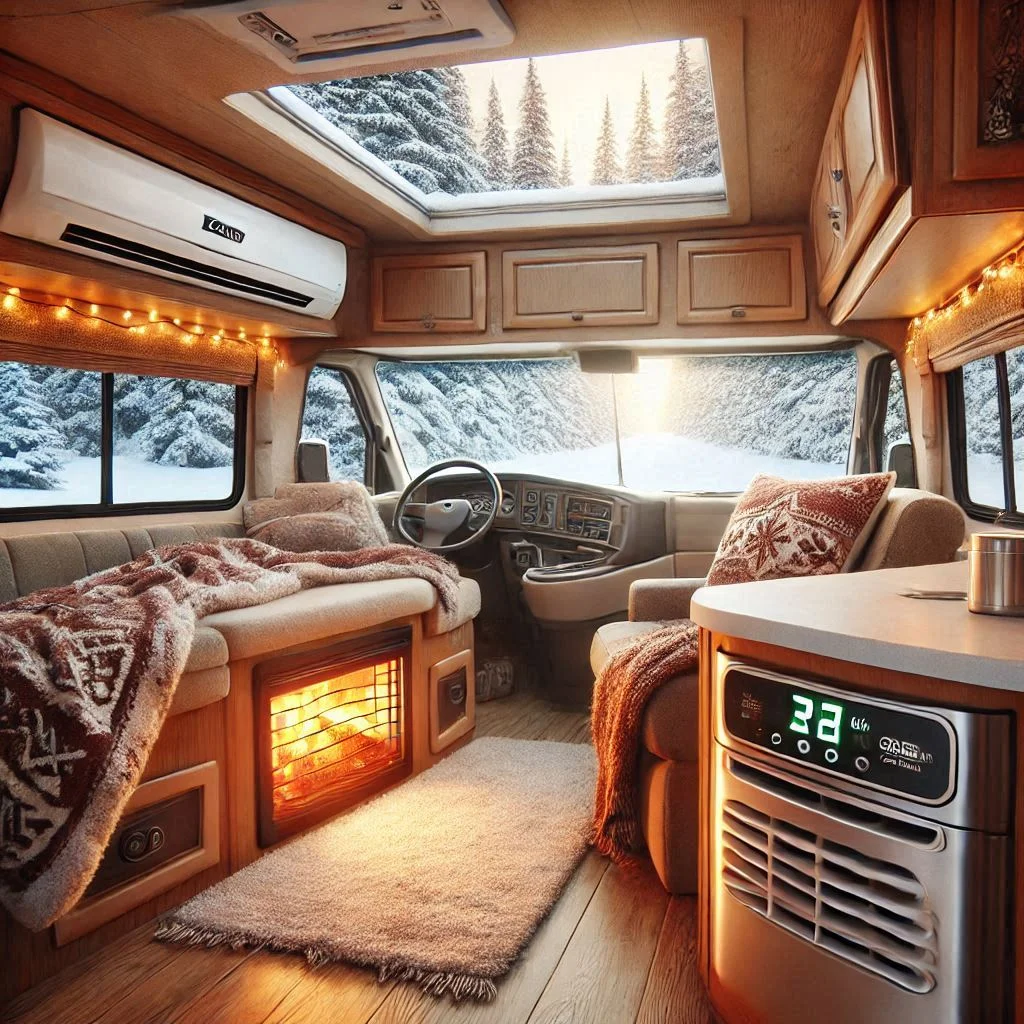
How 12V Air Conditioners Work
The Basics of 12V Air Conditioning Systems
12V air conditioners are specifically designed for mobile applications like RVs, campervans, and boats. They utilize a direct current (DC) power supply, making them energy-efficient and suitable for off-grid living. Here’s how they work:
- Power Source
These systems operate on 12V DC, which can be drawn directly from the vehicle’s battery, a dedicated RV power bank, or solar-powered battery systems. This eliminates the need for inverters, which are required to convert DC to AC for traditional air conditioners. - Compressor and Refrigerant Cycle
- The compressor circulates refrigerant through the system, absorbing heat from inside the RV and releasing it outside.
- Modern 12V units use advanced compressors to achieve high cooling efficiency with minimal power consumption.
- Thermostatic Control
Most units come with digital thermostats, allowing users to set precise temperature levels for maximum comfort. Some even include smartphone connectivity for remote control. - Ventilation and Airflow
These air conditioners are equipped with optimized fans and vents that evenly distribute cool air throughout the space, ensuring every corner of the RV is comfortable.
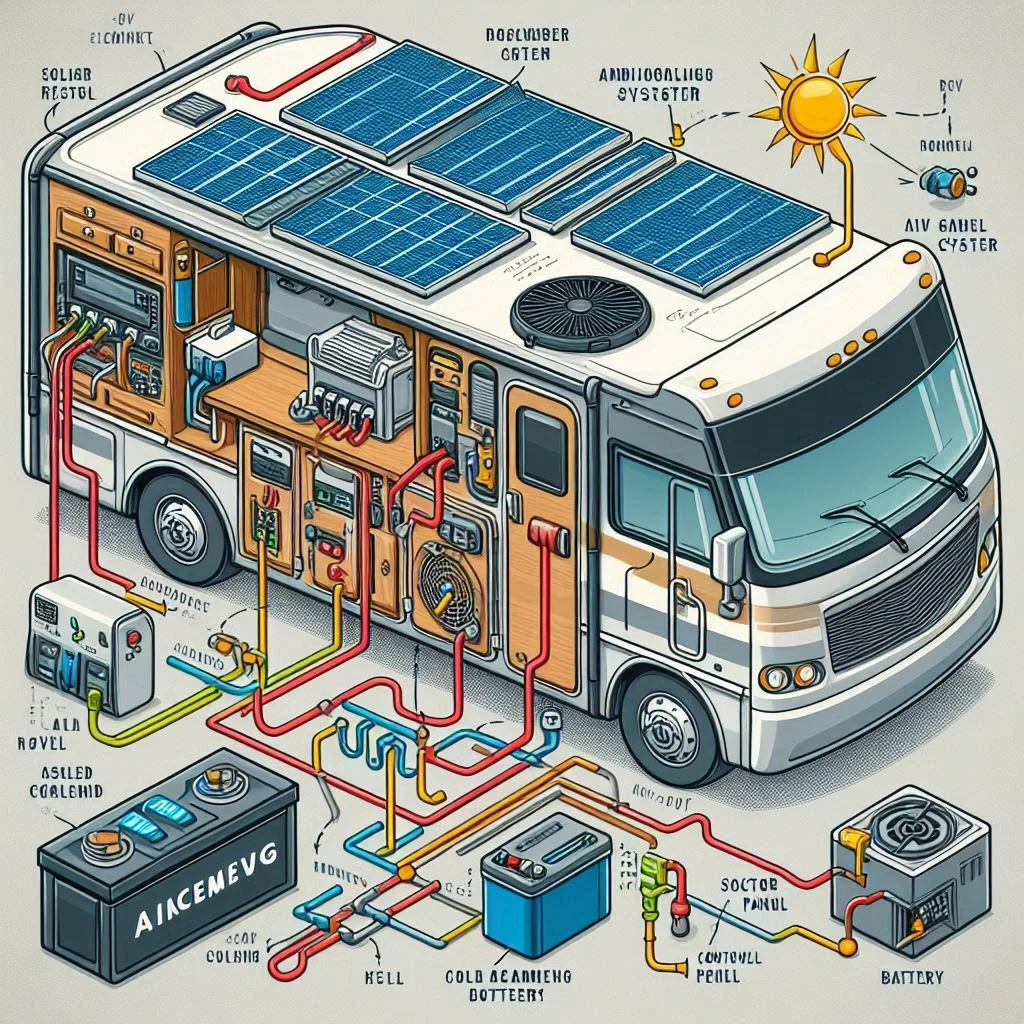
Heating Capabilities in Winter
Many modern 12V air conditioning units are dual-purpose, providing both cooling in the summer and heating during colder months. Here’s how they handle heating:
-
- Some 12V air conditioners use reverse-cycle heat pump technology. This allows the system to extract heat from the outside air and circulate it inside the RV, even in chilly conditions.
- This method is energy-efficient and can maintain warmth without heavily draining the battery.Heat Pump Technology
- Electric Heating Element
- Certain models incorporate an electric heating element to provide supplementary warmth. This is particularly useful in extremely cold weather where heat pumps might struggle.
- Year-Round Comfort
- Dual-purpose functionality ensures that a single system can meet your climate control needs throughout the year, reducing the need for separate heating devices.
- Cost and Energy Savings
- By utilizing a single unit for both heating and cooling, RV owners save on upfront costs and reduce energy consumption.
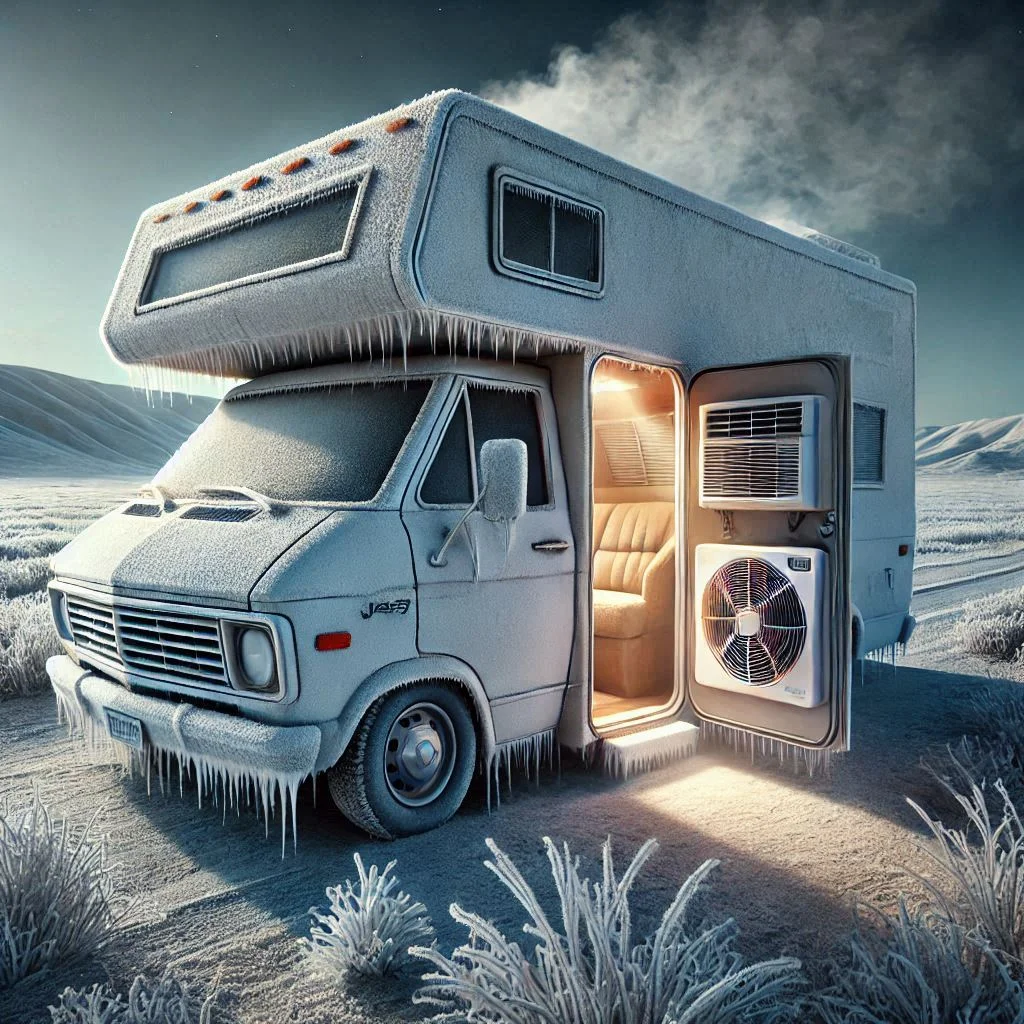
Optimize Your RV Comfort With a 12V Air Conditioner
By understanding the operational basics and heating capabilities of 12V air conditioners, RV owners can make informed choices that enhance comfort and efficiency. Whether it’s the height of summer or the depth of winter, these systems ensure a perfect indoor climate, wherever your travels take you.
Top Features to Look for in a 12V RV Air Conditioner
When choosing the perfect 12V RV air conditioner, it’s essential to consider key features that impact performance, efficiency, and comfort. Understanding these features ensures you select a unit tailored to your needs and enhances your RV lifestyle.
Energy Efficiency and Power Consumption
Energy efficiency is a top priority for RV air conditioners, especially when off-grid. A highly efficient 12V unit ensures optimal cooling without depleting your battery.
-
- The best 12V air conditioners consume minimal power while delivering effective cooling. Many models are designed to run on solar-charged batteries, reducing dependence on generators or shore power.Low Power Draw
- Eco-Friendly Operation
- These systems reduce energy waste, helping you save on fuel and electricity costs while minimizing your environmental footprint.
- Look for units with energy ratings and certifications to ensure top-tier efficiency.
- Smart Power Management Features
- Advanced models include features like auto power adjustment, which modulates energy use based on ambient temperature and load.
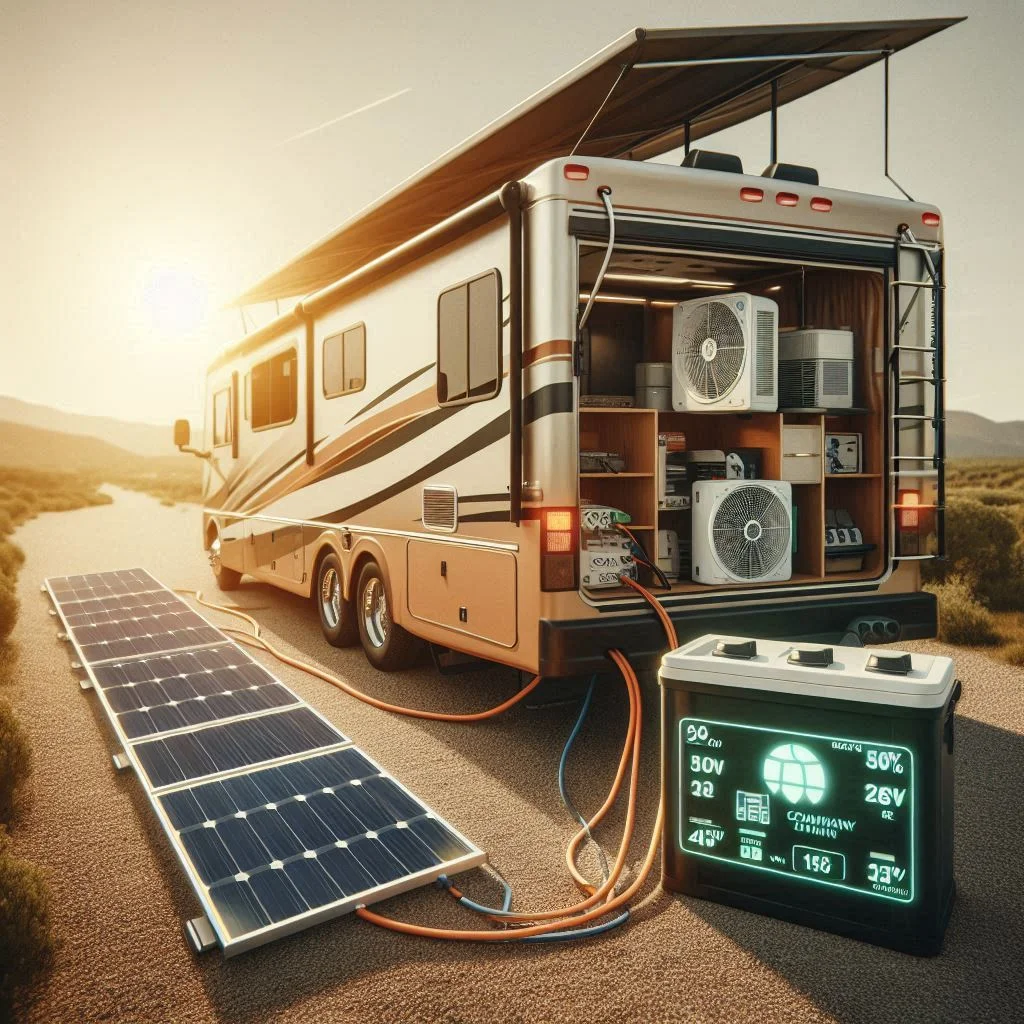
Cooling Capacity and BTU Ratings
Cooling capacity, measured in BTUs (British Thermal Units), is a critical factor that determines how well a 12V air conditioner can cool your RV.
- Matching BTU Ratings to RV Size
- A small camper may require a unit with 5,000–6,000 BTUs, while larger RVs might need 12,000–15,000 BTUs. Choosing the right capacity ensures efficient cooling without overworking the unit.
- Quick Cooling Features
- Many units are designed to provide rapid cooling, ensuring your RV reaches a comfortable temperature within minutes.
- Some systems offer zoned cooling, allowing you to direct airflow to specific areas for better temperature management.
- Seasonal Versatility
- Dual-purpose units with both cooling and heating modes often provide adaptable BTU ranges, making them suitable for year-round use.
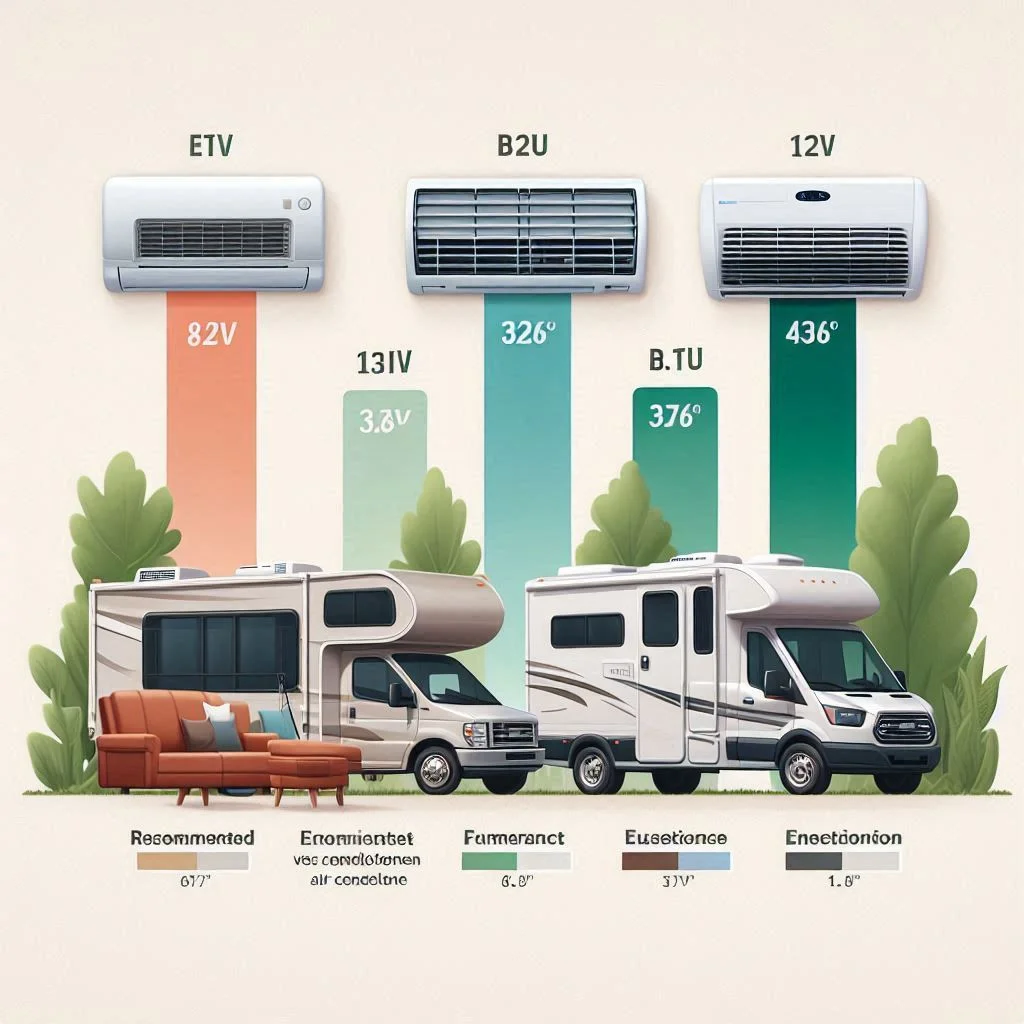
Noise Levels and Vibration Control
A quiet air conditioner can make a significant difference in your RV living experience, especially during overnight use.
- Decibel Ratings
- The best 12V air conditioners operate at noise levels as low as 40–50 decibels, ensuring peaceful sleep and undisturbed conversations.
- Innovative designs incorporate vibration-reducing components to minimize operational noise caused by compressors and fans.
- Proper mounting systems also play a crucial role in noise reduction.Advanced Vibration Dampening
- Noise-Optimized Fans
- Multi-speed fans allow you to adjust airflow while maintaining quiet operation, especially at night or during leisure time.
- Look for units with brushless motors, as they tend to be quieter and longer-lasting.
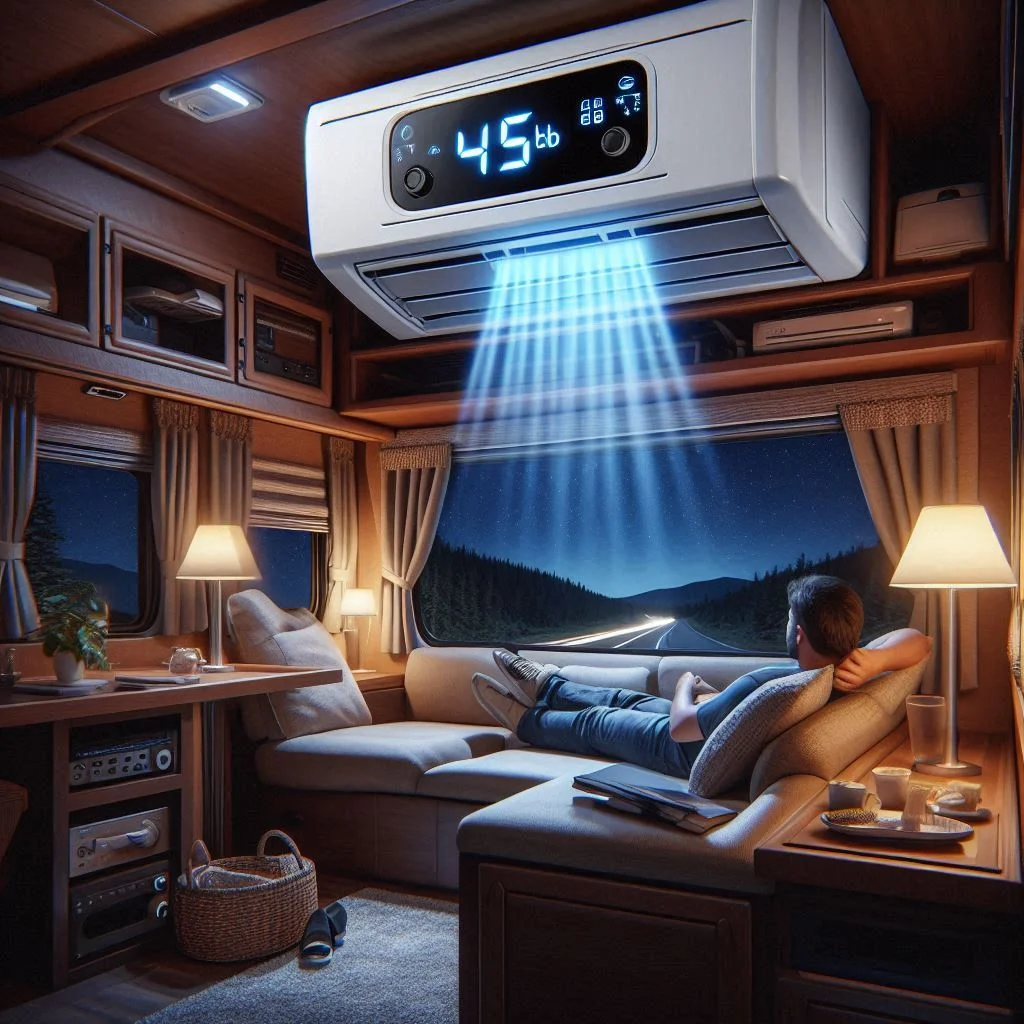
Optimize Your Comfort with the Right 12V Air Conditioner
By focusing on energy efficiency, appropriate BTU ratings, and quiet operation, you can select a 12V air conditioner that not only meets your cooling needs but also ensures maximum comfort and sustainability during your RV adventures.
Comparing the Best 12V RV Air Conditioners
Choosing the right 12V RV air conditioner is crucial for comfort and efficiency on the road. Here’s a detailed comparison of the best options available, focusing on features, performance, and ideal use cases.
Best Overall: Nomadic Cooling X2
The Nomadic Cooling X2 stands out for its superior performance, durability, and energy efficiency.
- Key Features
- Cooling Capacity: Up to 12,000 BTUs, suitable for medium to large RVs.
- Power Efficiency: Consumes as little as 30 amps at full load, making it ideal for solar-powered systems.
- Smart Controls: Includes Wi-Fi connectivity for remote operation via a smartphone app.
- Why It’s the Best
- Combines powerful cooling with advanced energy-saving features, making it perfect for off-grid enthusiasts.
- Built with high-quality materials to withstand rugged conditions.
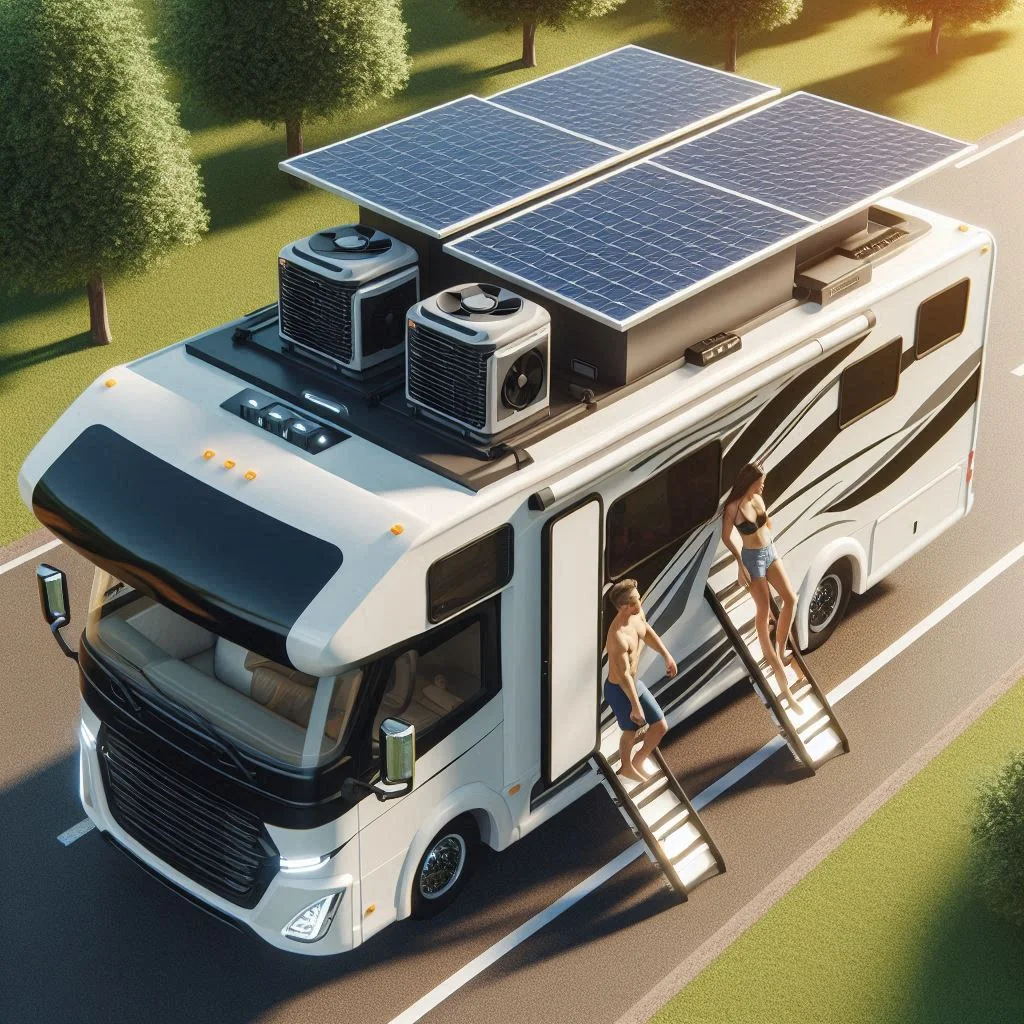
Best Value: Dometic RTX 2000
The Dometic RTX 2000 is an excellent balance of performance and affordability.
- Key Features
- Cooling Capacity: 6,800 BTUs, making it ideal for small to medium-sized RVs.
- Efficient Power Usage: Operates on just 19 amps in eco-mode, ensuring minimal battery drain.
- Quiet Operation: Runs at only 42 decibels, even at maximum output.
- Why It’s the Best Value
- Offers premium features at a competitive price, providing reliable performance without breaking the bank.
- Perfect for RV owners seeking an affordable yet effective cooling solution.
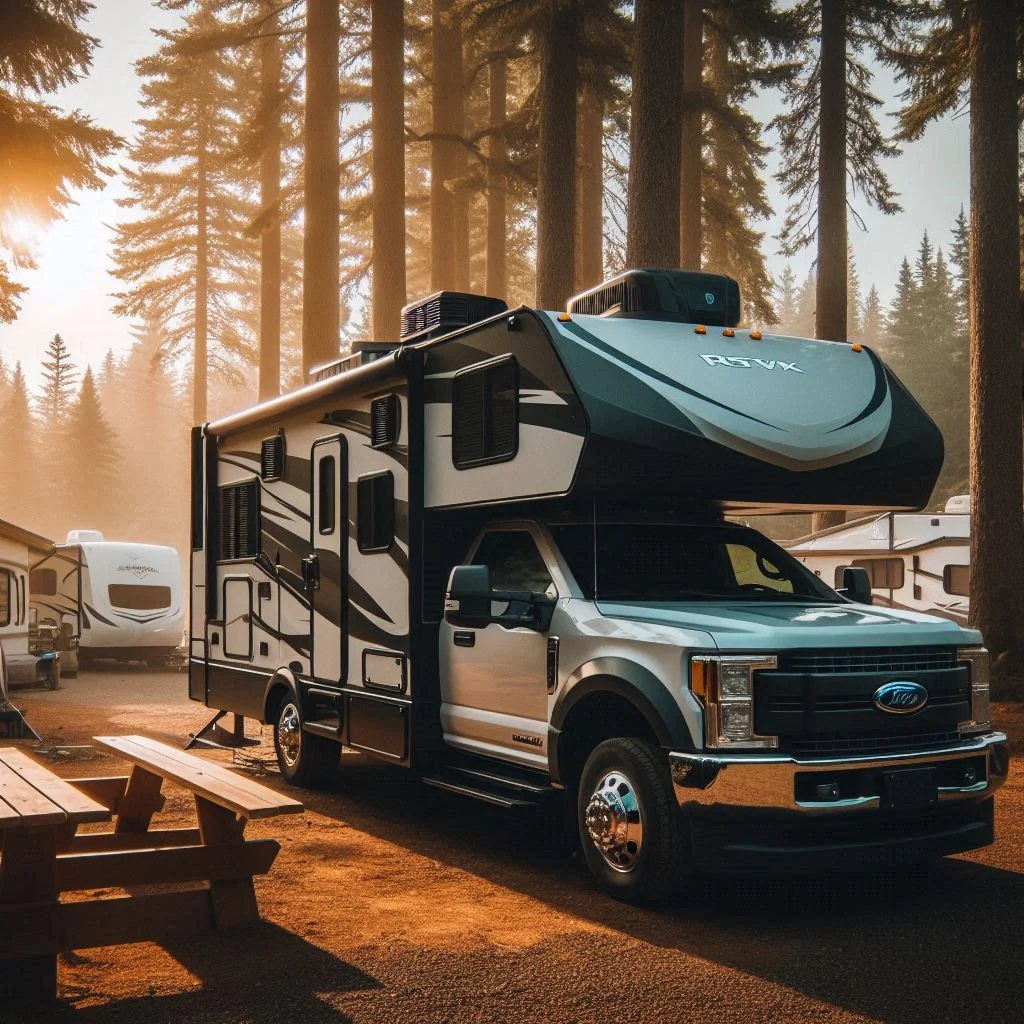
Best Portable: Zero Breeze Mark 2
For those needing flexibility, the Zero Breeze Mark 2 is the ultimate portable air conditioner.
- Key Features
- Portability: Lightweight and compact design, easy to move and set up in any space.
- Battery-Operated: Comes with a rechargeable battery, making it perfect for off-grid use.
- Cooling Power: Delivers up to 2,300 BTUs, sufficient for cooling small areas.
- Why It’s the Best Portable Option
- Ideal for RVs, tents, and even outdoor use, offering versatile cooling wherever you need it.
- Rechargeable battery lasts up to 5 hours, depending on the usage mode.
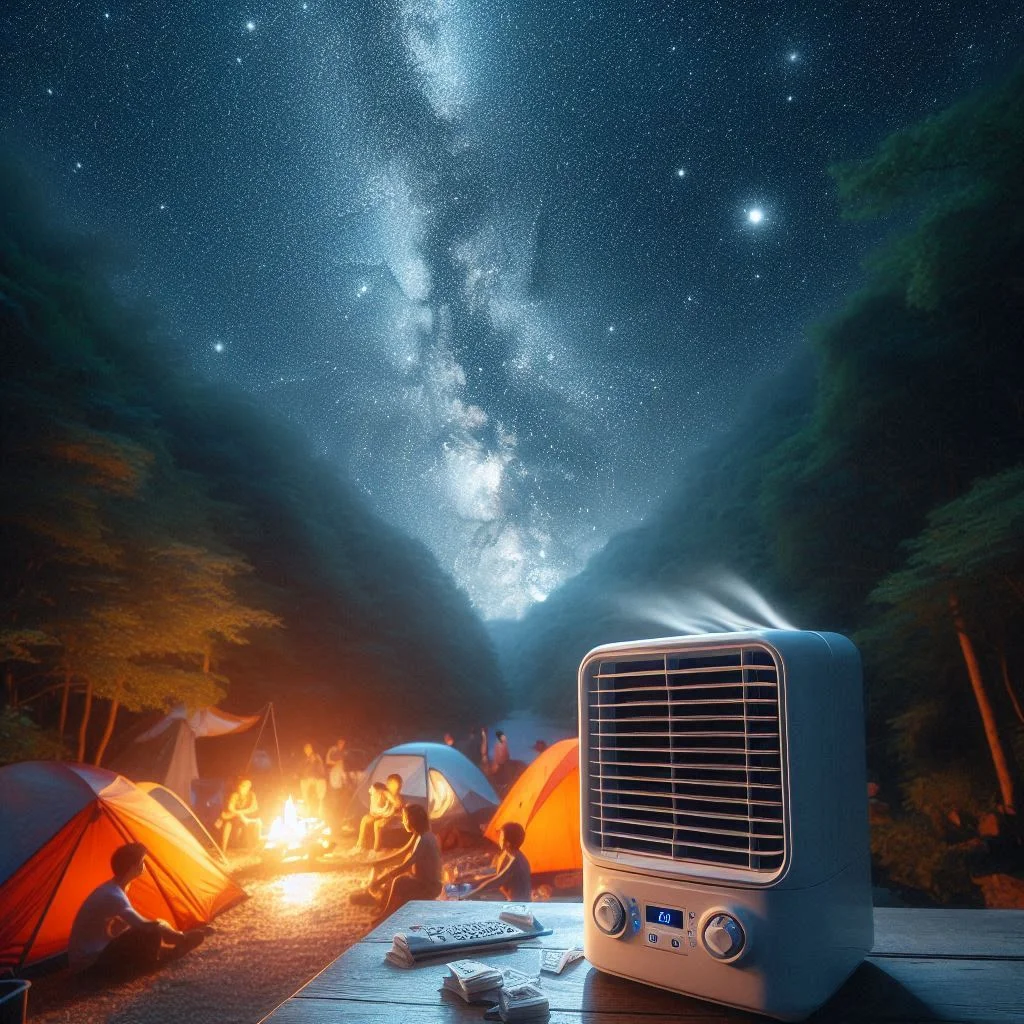
Best Quiet Option: B-Cool 12000RV
If silence is golden, the B-Cool 12000RV delivers whisper-quiet performance without compromising cooling power.
- Key Features
- Noise Level: Operates at only 40 decibels, ensuring peaceful environments.
- BTU Rating: Offers up to 12,000 BTUs, capable of cooling large RV interiors.
- Energy Efficiency: Optimized for low power consumption, compatible with solar setups.
- Why It’s the Best Quiet Option
- Ideal for nighttime use or when you’re in a serene location, allowing for uninterrupted rest and relaxation.
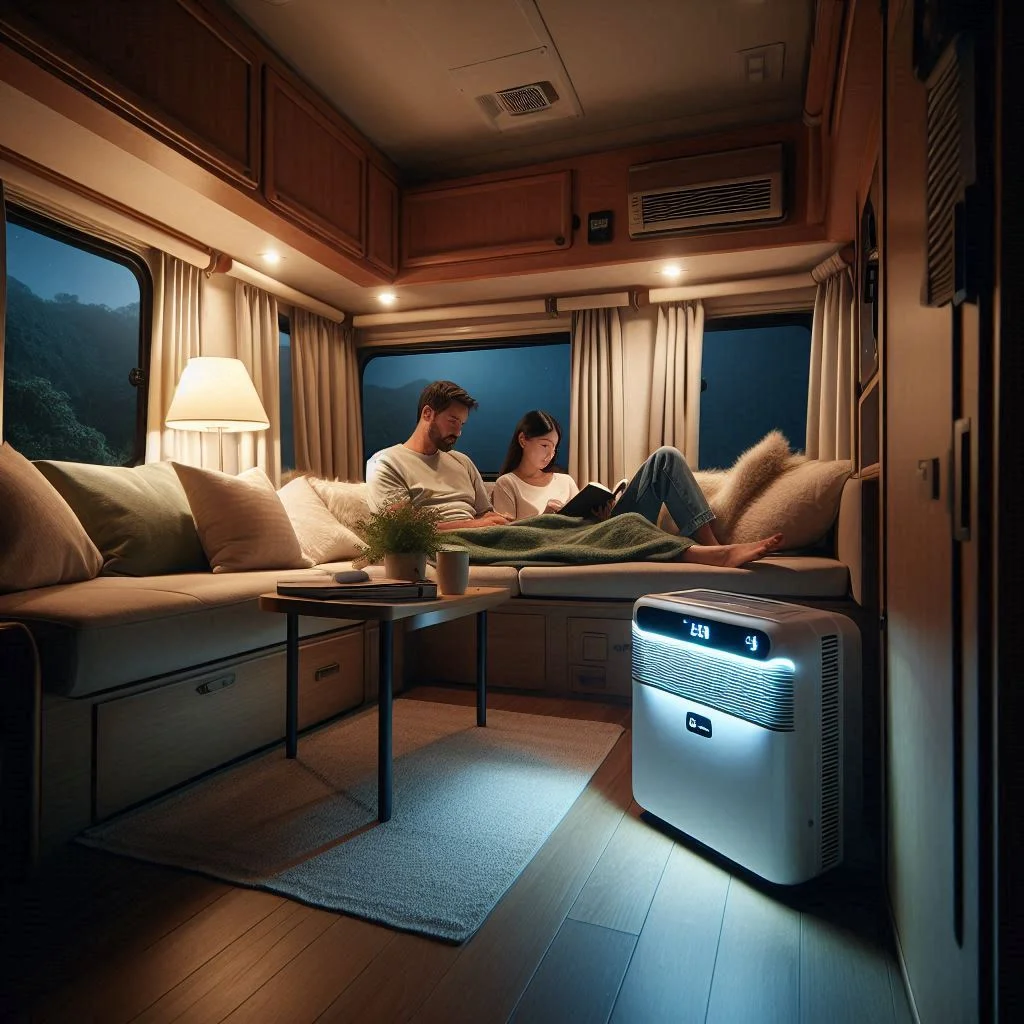
Best Heavy Duty: Cruise N Comfort USA HD-12L
The Cruise N Comfort USA HD-12L is engineered for extreme conditions and high-demand applications.
- Key Features
- Rugged Build: Designed for heavy-duty use in hot climates and long-haul travels.
- Cooling Capacity: Up to 15,000 BTUs, suitable for the largest RVs or motorhomes.
- Dual Zone Capabilities: Offers customizable cooling for different sections of the RV.
- Why It’s the Best Heavy Duty Option
- Built to last in extreme heat and challenging terrains, ensuring reliable performance under stress.
- Perfect for adventurers who frequently travel through deserts or tropical climates.
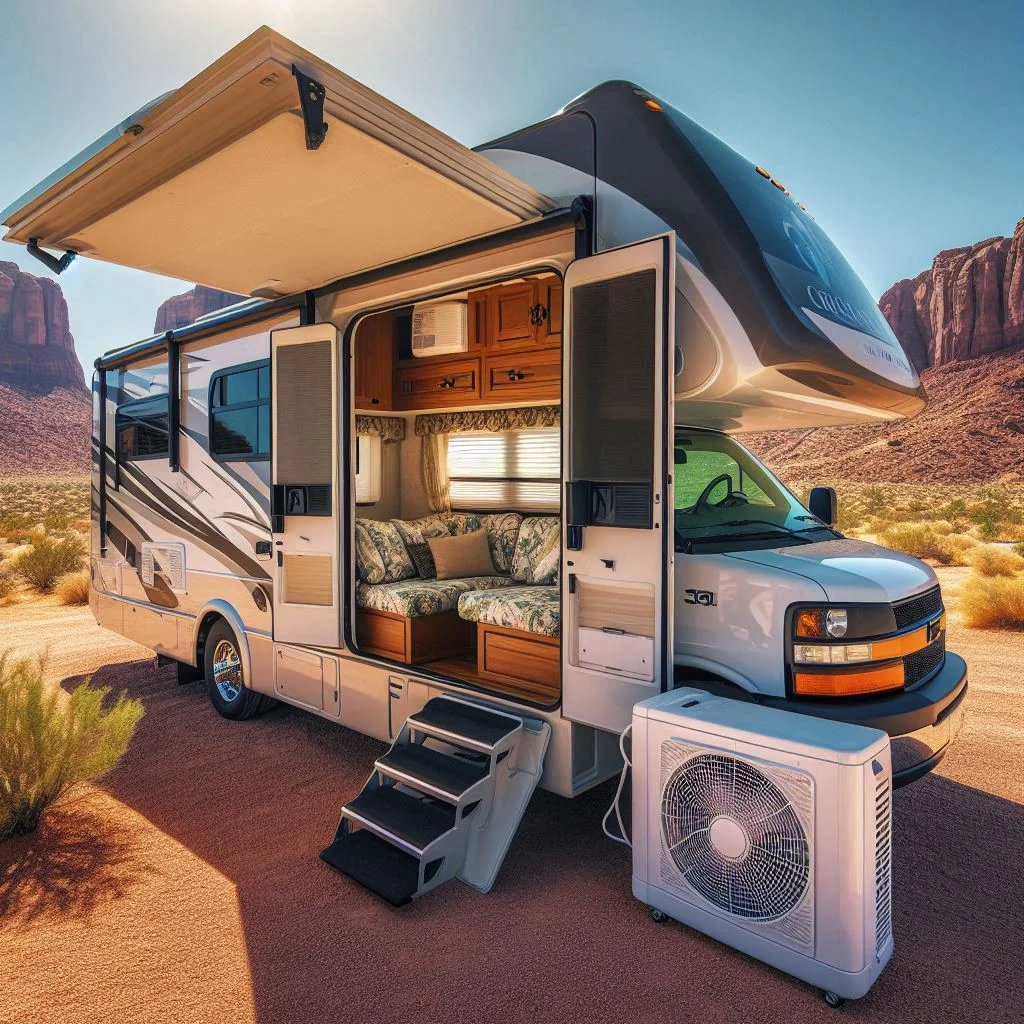
Optimize Your RV Cooling Experience
Whether you prioritize portability, energy efficiency, or quiet operation, there’s a 12V air conditioner tailored to your needs. Choose wisely to ensure optimal comfort and performance during your RV adventures.
Installation and Maintenance Tips for 12V RV Air Conditioners
Installing and maintaining a 12V RV air conditioner properly ensures optimal performance and a longer lifespan. This guide provides a comprehensive look at the tools, installation steps, and maintenance tips to keep your unit in top condition.
Tools and Materials Needed for Installation
Before beginning the installation, ensure you have all the necessary tools and materials. This preparation minimizes downtime and ensures a smooth installation process.
- Essential Tools
- Screwdriver set (Phillips and flathead)
- Power drill with drill bits
- Wire strippers and crimping tool
- Multimeter for electrical testing
- Wrench set for mounting bolts
- Measuring tape
- Required Materials
- 12V air conditioner unit
- Mounting brackets or hardware (supplied with the unit)
- Electrical cables (high gauge for power connections)
- Insulation tape or heat shrink tubing
- Sealant (to ensure waterproof installation)
- Duct tape for temporary fixes
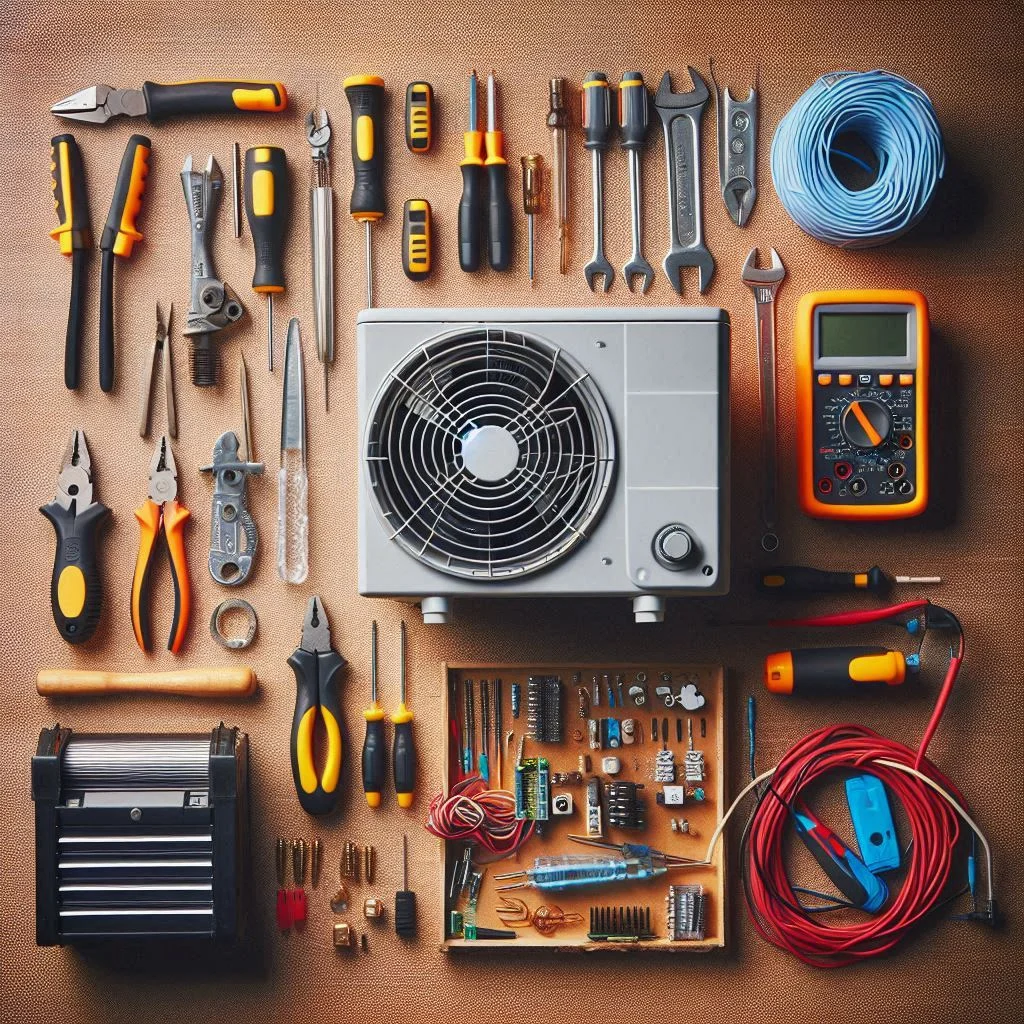
Step-by-Step Installation Process
Proper installation is critical for the efficient operation of your 12V RV air conditioner. Follow these steps carefully:
- Prepare the Installation Area
- Measure and mark the mounting location on the roof or interior of the RV.
- Ensure the surface is clean and dry for secure placement.
- Install the Mounting Hardware
- Drill holes for the mounting brackets and secure them using screws or bolts.
- Use sealant around the drilled holes to prevent water leakage.
- Position the Air Conditioner
- Place the unit on the mounting brackets, ensuring it aligns with the pre-marked areas.
- Secure the unit firmly to prevent vibrations during operation.
- Connect the Electrical System
- Run the wires from the air conditioner to the RV’s power supply or battery system.
- Use wire strippers to prepare the connections and secure them with crimp connectors or solder.
- Test the connections with a multimeter to ensure proper voltage.
- Final Setup
- Install the interior vent and control panel.
- Test the unit to ensure it starts correctly and cools effectively.
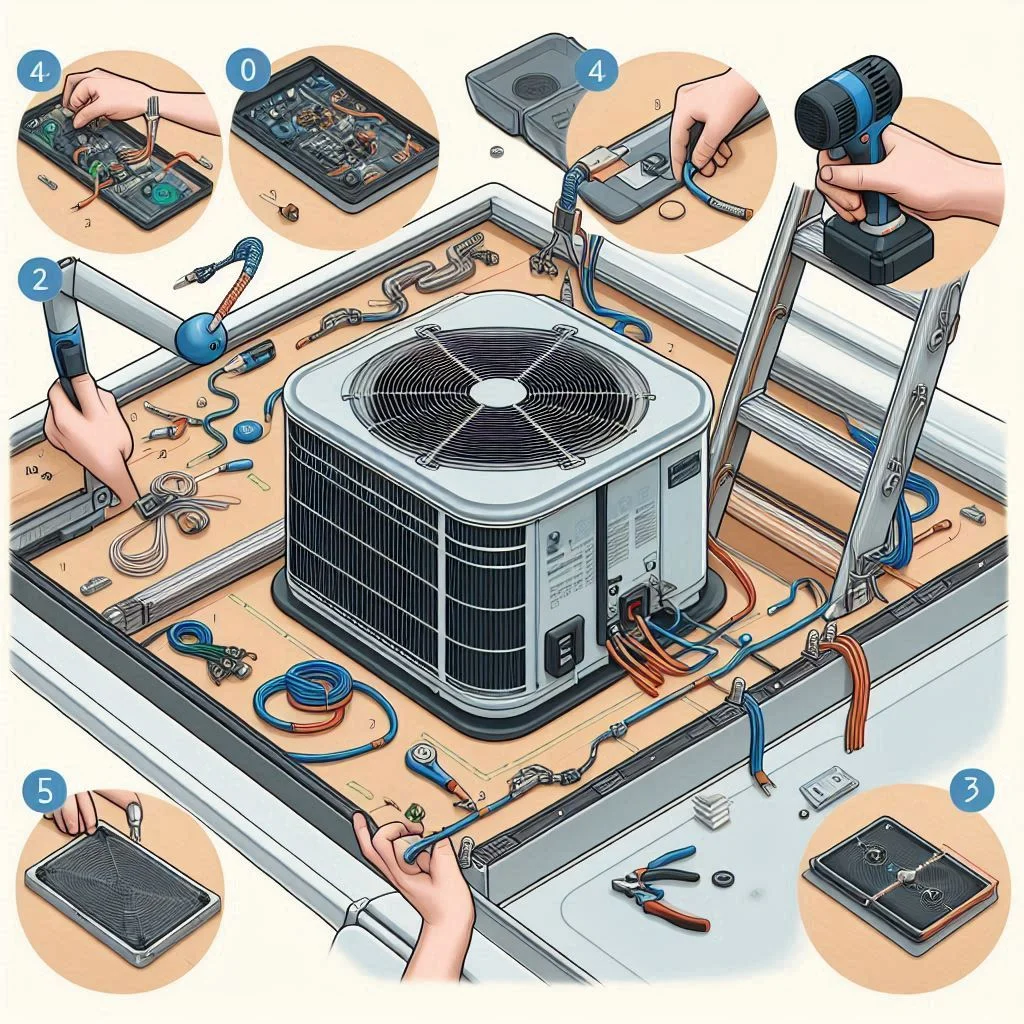
Routine Maintenance and Troubleshooting Tips
Routine maintenance ensures your air conditioner operates at peak efficiency and reduces the likelihood of breakdowns.
- Filter Cleaning and Replacement
- Remove and clean the air filters every month to prevent dust buildup.
- Replace filters every 6–12 months for optimal airflow.
- Inspect for Leaks
- Regularly check for refrigerant leaks, as they can reduce cooling efficiency.
- Use a leak detection kit or hire a professional for inspection.
- Clean the Coils
- Condenser and evaporator coils should be cleaned every 3–6 months to ensure effective heat exchange.
- Use a soft brush or coil cleaner to remove dirt and debris.
- Electrical System Checks
- Inspect wires for wear or corrosion, especially at connection points.
- Tighten any loose connections and replace damaged wires promptly.
5.Troubleshooting Common Issues
- Unit Not Starting: Check the power source and fuse box. Ensure the battery is charged and connections are secure.
- Insufficient Cooling: Inspect for dirty filters, blocked vents, or low refrigerant levels.
- Unusual Noises: Tighten mounting bolts and check for loose parts.
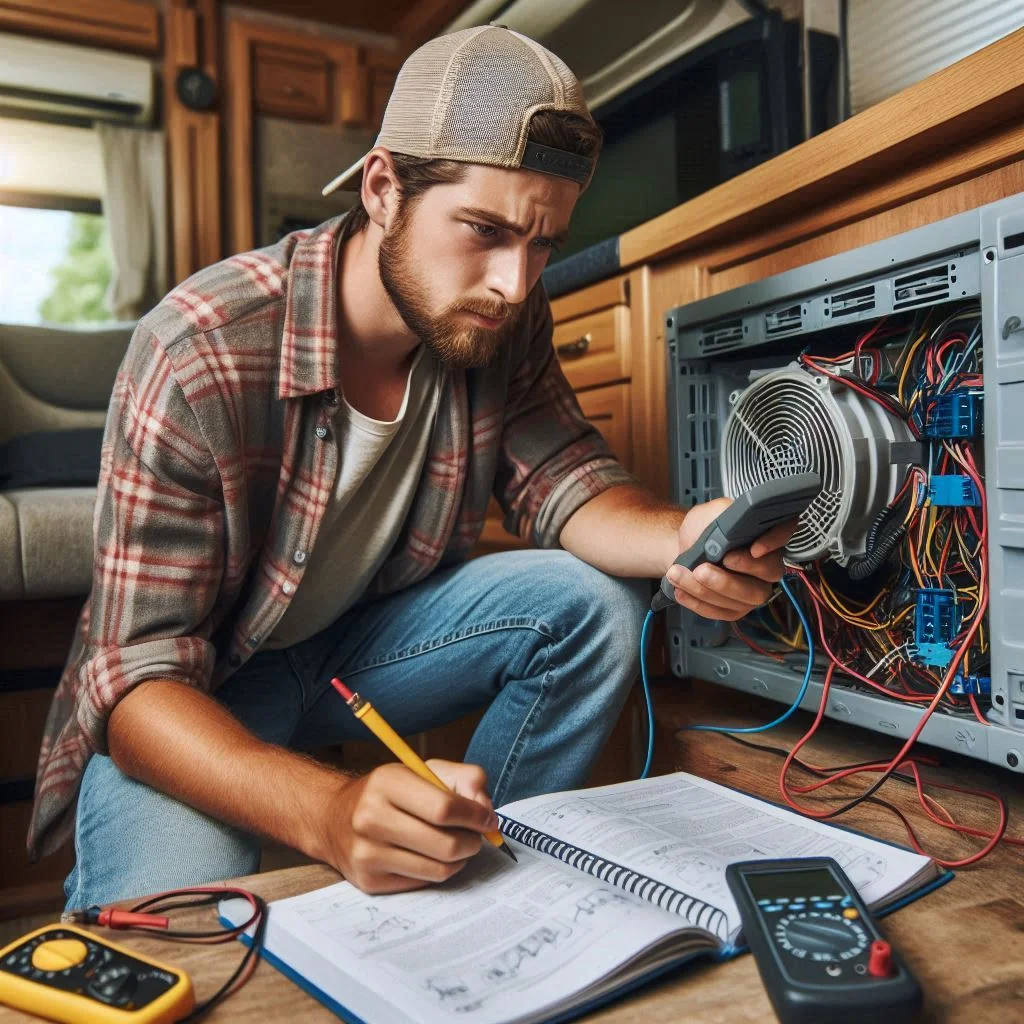
Enhance the Longevity of Your Air Conditioner
By following these installation and maintenance tips, you can maximize the performance and lifespan of your 12V RV air conditioner. Proper care ensures a comfortable RV experience, no matter where the road takes you.
Budgeting for a 12V RV Air Conditioner
Investing in a 12V RV air conditioner can significantly improve comfort during your travels. Proper budgeting ensures you get the best value while avoiding overspending. This section details price ranges, expectations, and the best times to make your purchase.
Price Ranges and What to Expect
The cost of a 12V RV air conditioner depends on factors such as brand, cooling capacity, features, and additional functionalities. Understanding these ranges helps you make an informed decision.
- Budget-Friendly Options ($500–$1,000)
- Typically, these models are basic units with limited cooling capacity (ideal for smaller RVs).
- Features: Standard cooling, manual controls, and moderate efficiency.
- Recommended For: Occasional travelers or those with smaller energy needs.
- Mid-Range Options ($1,000–$2,000)
- These units offer better energy efficiency, larger cooling capacity, and quieter operation.
- Features: Digital controls, compatibility with solar power systems, and higher BTU ratings.
- Recommended For: Regular travelers seeking a balance between cost and performance.
- Premium Options ($2,000–$3,500)
- Designed for heavy-duty cooling with advanced features like smart connectivity and dual-use (cooling and heating).
- Features: Superior noise control, robust build quality, and extended warranties.
- Recommended For: Full-time RVers or those living in extreme climates.
- Additional Costs
- Installation: Professional installation can cost $200–$500, depending on the complexity.
- Maintenance: Routine upkeep, such as filter replacements and refrigerant refills, averages $50–$150 annually.
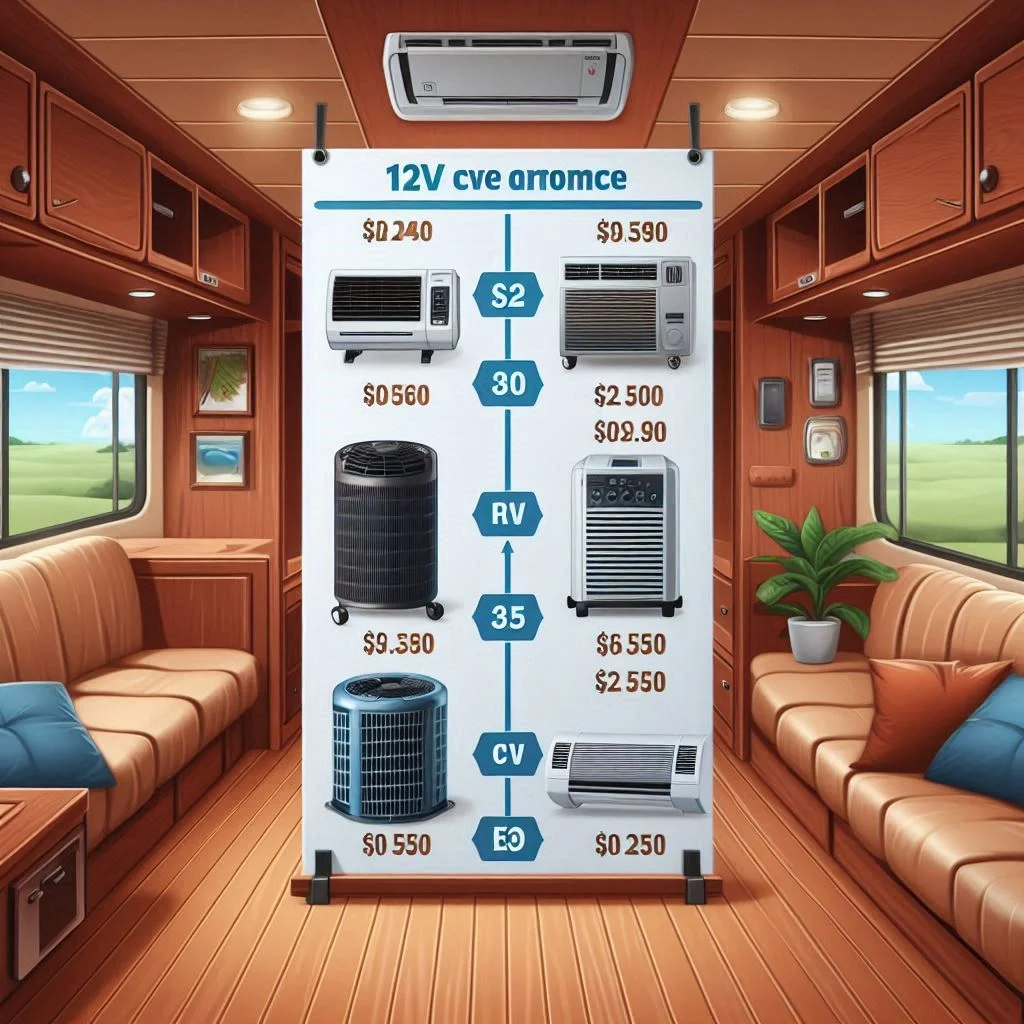
When Is the Best Time to Buy an Air Conditioner?
Timing your purchase strategically can save you hundreds of dollars. Here’s when to shop for the best deals:
- Off-Season Purchases (Fall and Winter)
- Air conditioners are in lower demand during cooler months, leading to significant discounts.
- Retailers often clear out old inventory to make room for new models, offering clearance sales.
- Pro Tip: Look for Black Friday, Cyber Monday, and holiday sales for additional savings.
- Seasonal Promotions
- Early spring promotions cater to RVers preparing for summer trips.
- Watch for manufacturer rebates or trade-in deals during these periods.
- End-of-Model-Year Sales
- Older models are frequently discounted when manufacturers launch new designs.
- These models often retain the same functionality as newer ones, making them a budget-friendly choice.
- Online vs. Local Retailers
- Online stores like Amazon and RV specialty sites often provide competitive pricing and free shipping.
- Local dealers may offer installation packages as part of the deal.

Maximizing Value for Your Budget
- Research and Compare
- Use comparison tools to evaluate features and pricing across brands.
- Read reviews from other RVers to ensure reliability and performance.
- Factor in Energy Efficiency
- Higher upfront costs for energy-efficient models can save on long-term energy consumption.
- Warranty and Support
- Choose units with comprehensive warranties and readily available customer service.
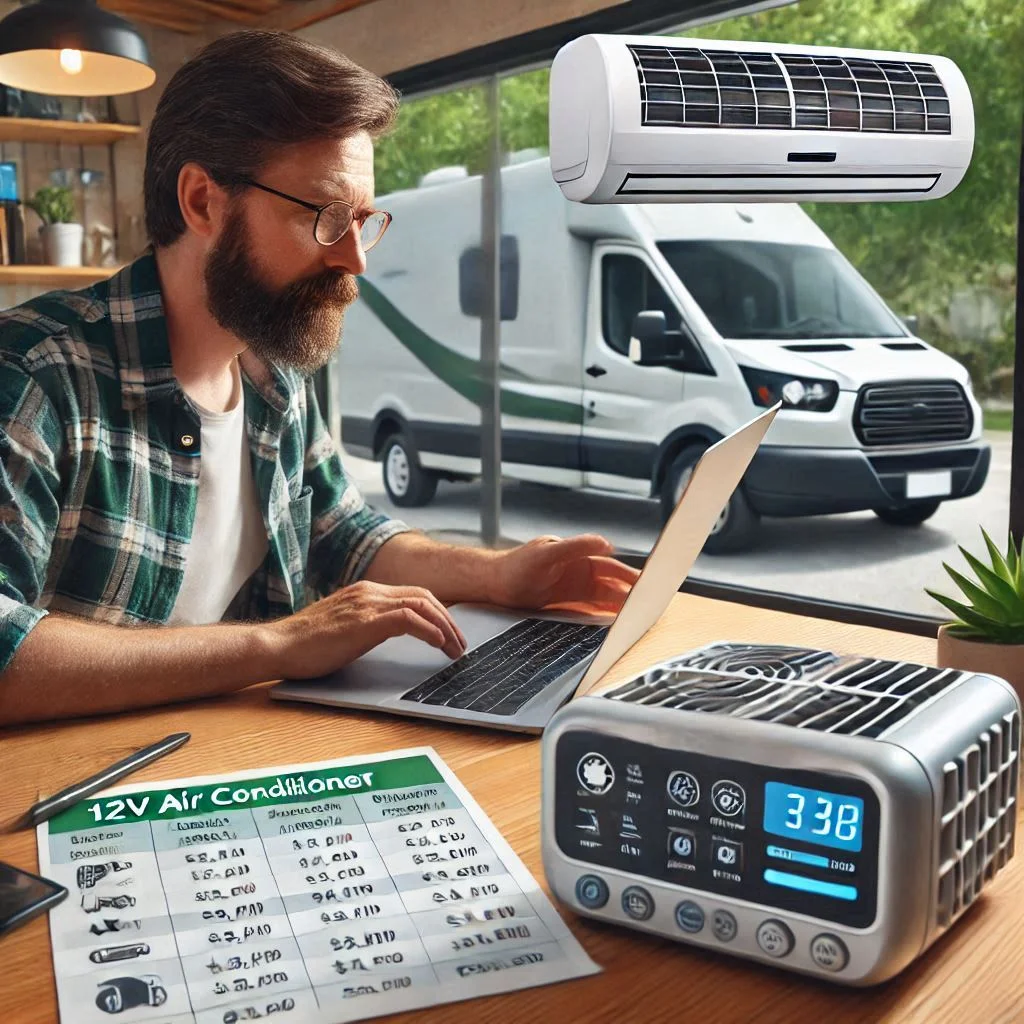
FAQs About the Best 12V RV Air Conditioner
To help you make informed decisions about investing in a 12V RV air conditioner, we’ve compiled answers to frequently asked questions. These insights cover power consumption, cooling capabilities, lifespan, installation, and solar power compatibility.
How Much Power Does a 12V Air Conditioner Use?
Power consumption depends on the unit’s size, BTU rating, and efficiency. On average:
- Typical Usage: A 12V air conditioner consumes 30–70 amps per hour, equating to 360–840 watts per hour.
- Factors Influencing Power Use:
- BTU rating (higher BTUs consume more power).
- Ambient temperature (hotter climates require more cooling).
- Runtime (continuous use vs. intermittent).
- Efficiency Models: Look for units with advanced inverter technology or eco-mode for reduced power consumption.
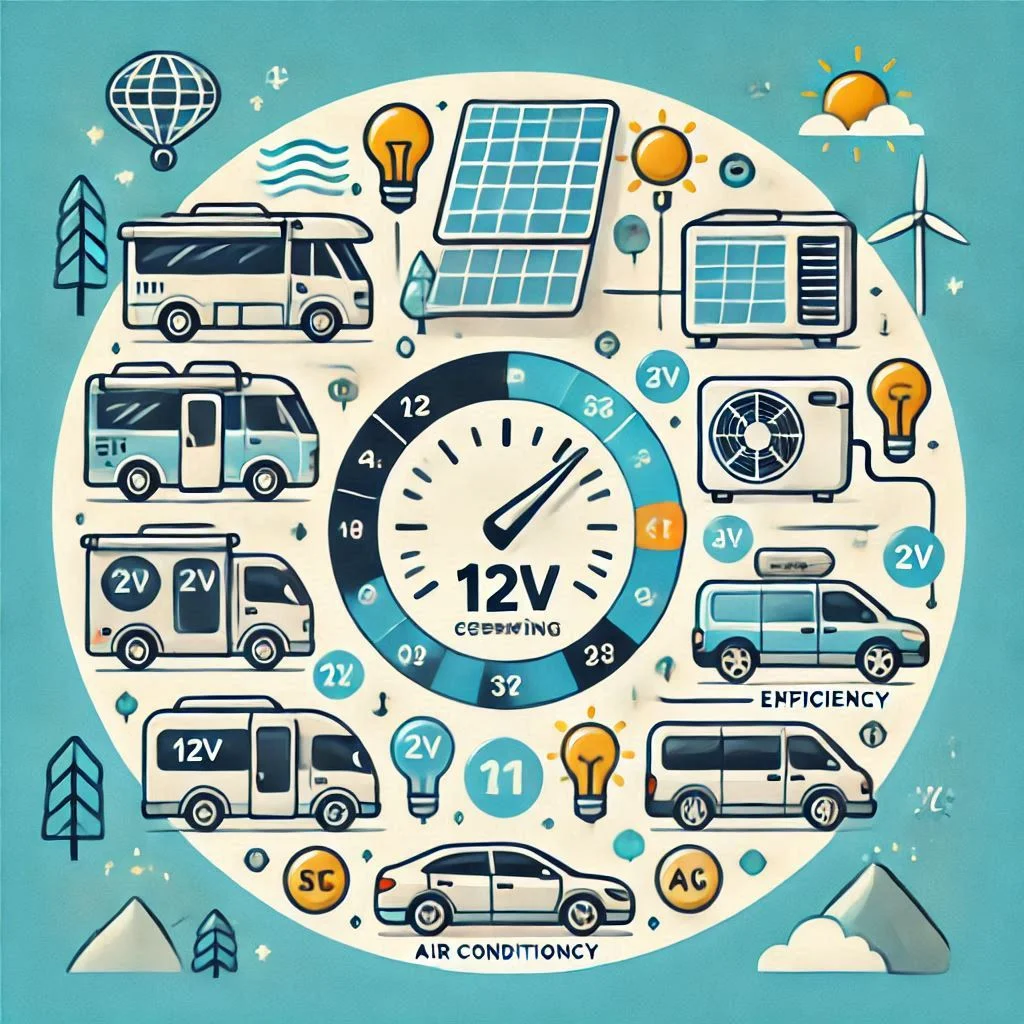
Can a 12V Air Conditioner Cool a Large RV?
12V air conditioners are suitable for small to mid-sized RVs, but their effectiveness in larger RVs depends on several factors:
- BTU Rating:
- Small RVs (20–30 feet): A 6,000–9,000 BTU unit is sufficient.
- Large RVs (30+ feet): Consider units with 10,000+ BTUs for better coverage.
- Insulation and Ventilation:
- Proper insulation minimizes heat gain, making it easier for the unit to cool effectively.
- Use thermal curtains and window shades to reduce solar heat entry.
- Supplemental Cooling:
- For large RVs, pair the 12V unit with fans or a second air conditioner for optimal results.
What Is the Average Lifespan of a 12V RV Air Conditioner?
The lifespan of a 12V RV air conditioner depends on maintenance and usage:
- Average Lifespan: 8–12 years with regular care.
- Maintenance Tips:
- Clean or replace filters every 3–6 months.
- Check refrigerant levels and address leaks promptly.
- Ensure proper ventilation around the unit to prevent overheating.
- Signs of Wear:
- Reduced cooling efficiency.
- Unusual noises or vibrations.
- Frequent cycling on and off.
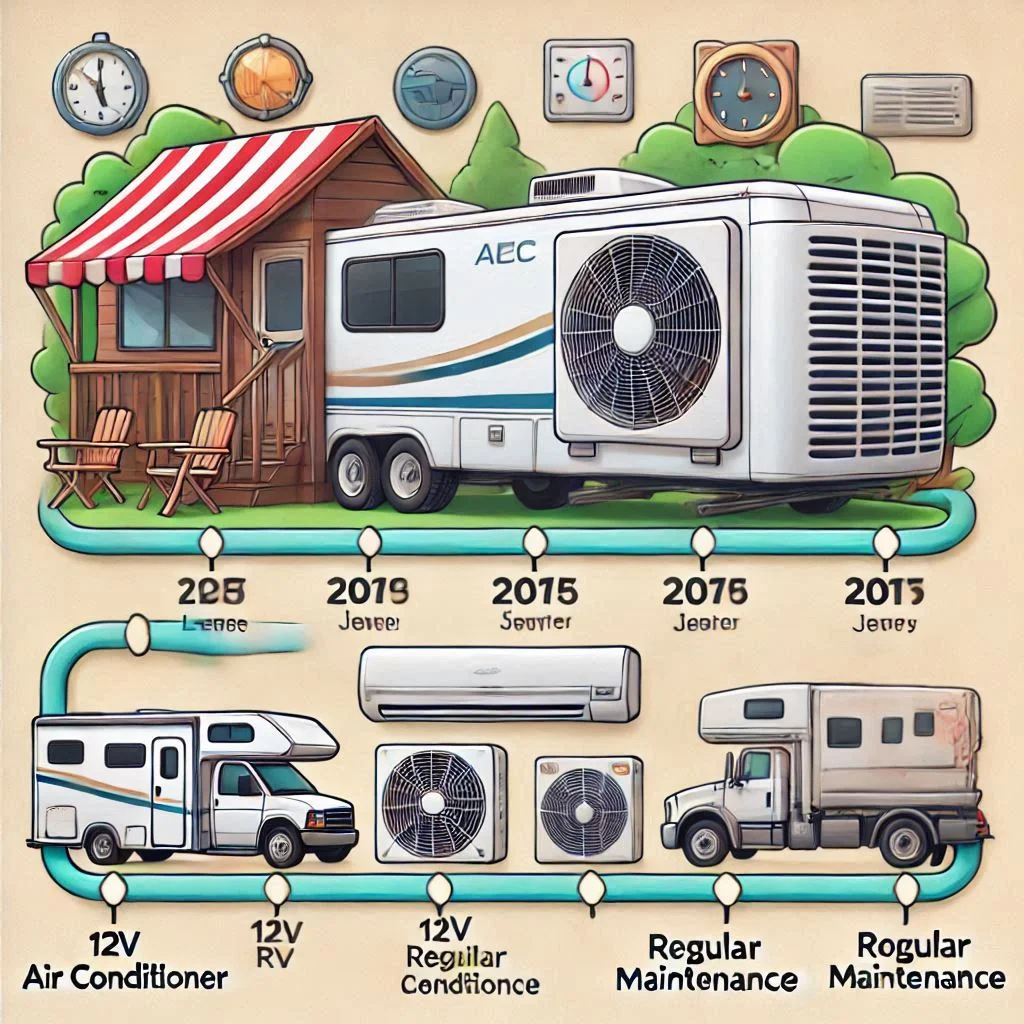
Are 12V Air Conditioners Easy to Install?
Installing a 12V air conditioner can be straightforward with the right tools and guidance. Here’s what you need to know:
- DIY Installation:
- Suitable for experienced DIYers familiar with electrical systems.
- Tools Required: Screwdrivers, wire connectors, sealant, and a voltage tester.
- Follow the manufacturer’s instructions carefully.
- Professional Installation:
- Recommended for complex installations or if roof modifications are needed.
- Cost: $200–$500, depending on labor rates and complexity.
- Key Considerations:
- Ensure the unit is compatible with your RV’s power system.
- Use proper insulation to prevent air leaks.
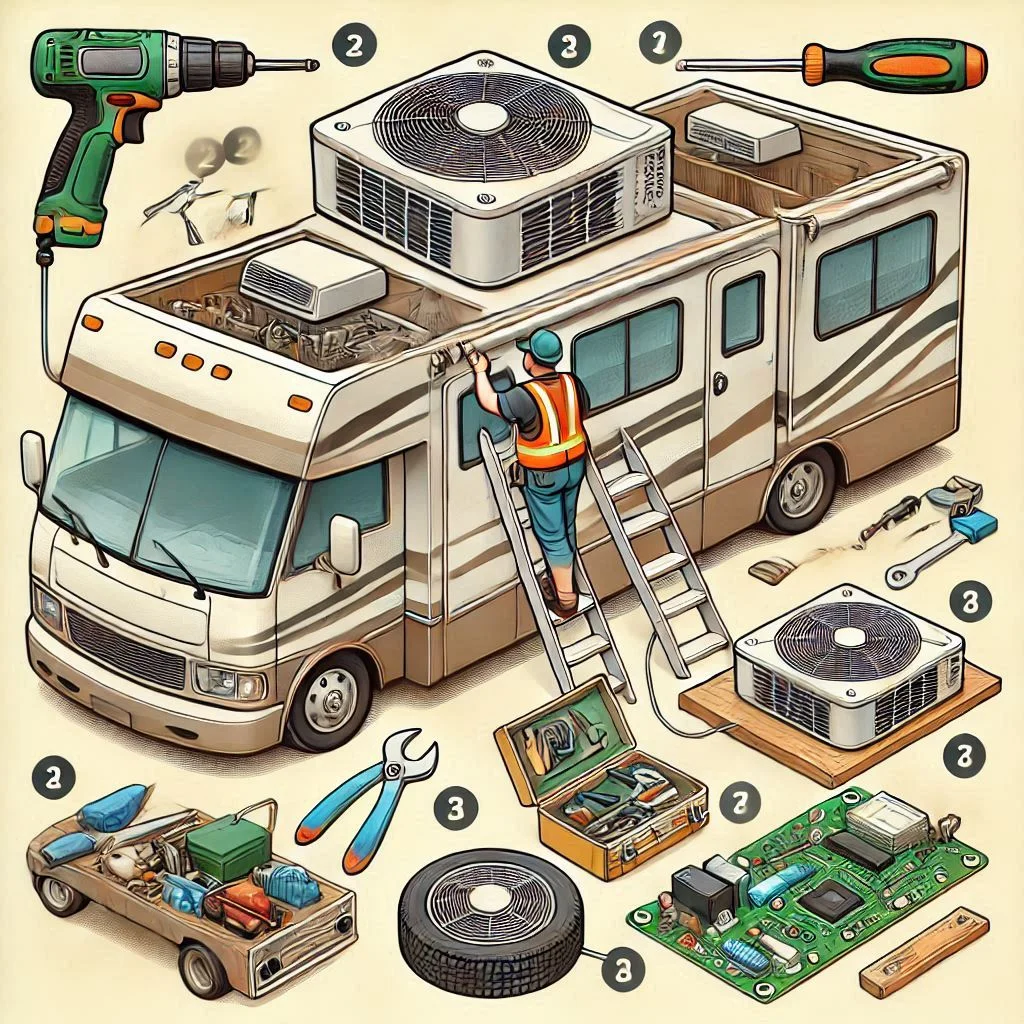
Can I Run a 12V Air Conditioner on Solar Power?
Yes, 12V air conditioners are compatible with solar power, making them an eco-friendly option for off-grid RVing.
- Solar Power Requirements:
- Solar Array Size: A 300–600W solar panel setup is sufficient for most units.
- Battery Bank: Use deep-cycle lithium-ion batteries with a capacity of 100Ah–300Ah to store power.
- System Efficiency:
- Pair with a solar charge controller to optimize energy use.
- Install energy-efficient units to reduce overall power consumption.
- Benefits:
- Lower environmental impact.
- Independence from traditional power sources, ideal for remote camping.
- Limitations:
- Performance may vary during cloudy days or in shaded areas.
- Requires a robust setup to run continuously.
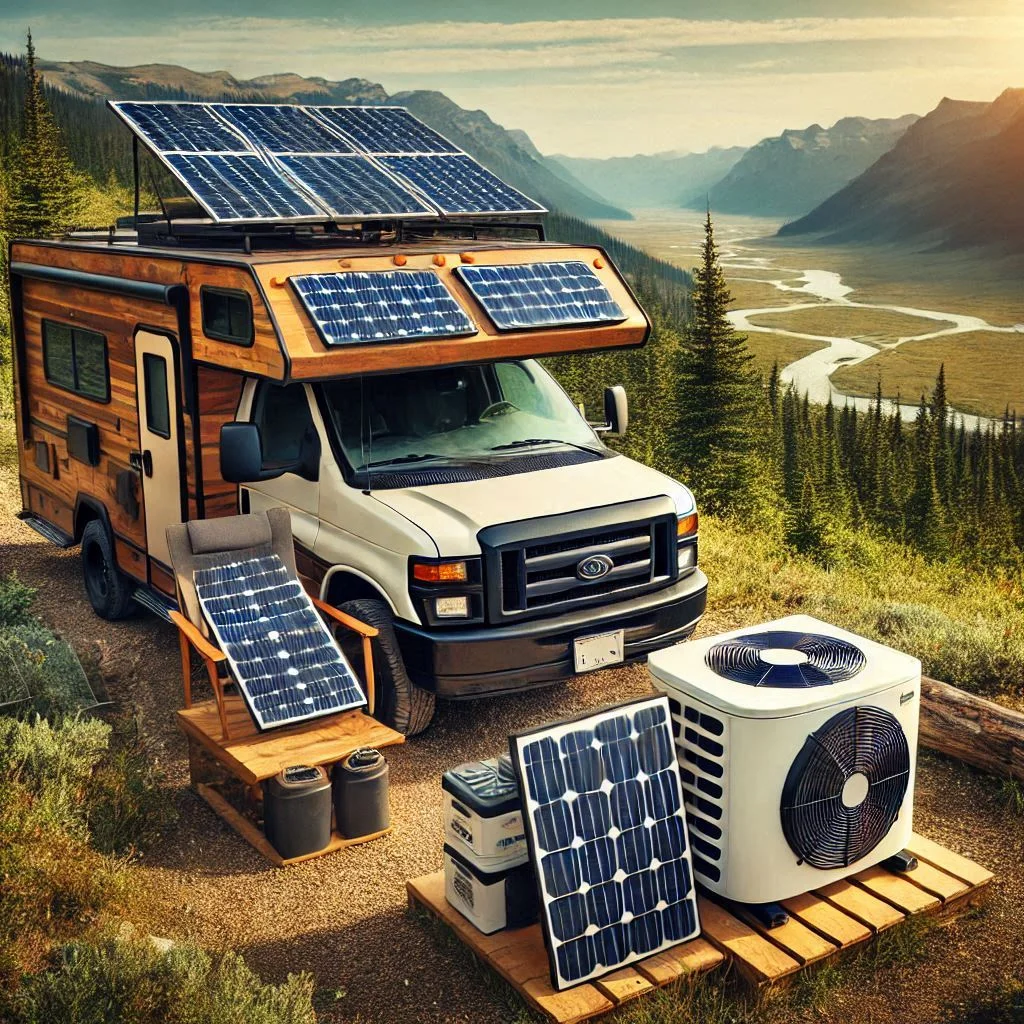
Conclusion
Investing in the best 12V RV air conditioner is a game-changer for comfort and convenience during your adventures. These compact yet powerful units are designed to provide efficient cooling, even off-grid, making them a must-have for modern RV enthusiasts. From energy efficiency and low noise levels to advanced cooling capabilities, a 12V air conditioner meets the unique demands of RV life. With the right model tailored to your needs, proper installation, and routine maintenance, you can enjoy years of reliable performance. Whether you’re parked under the blazing sun or exploring remote destinations, a 12V RV air conditioner ensures you stay cool and comfortable every mile of the way.

